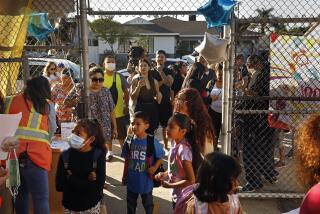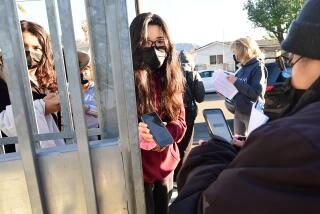California could begin new school year as early as July, Gov. Newsom says

- Share via
The academic year could start in late July or early August to address learning losses brought on by coronavirus-forced school closures affecting about 6.1 million California students, Gov. Gavin Newsom said Tuesday.
“We recognize there’s been a learning loss because of this disruption. We’re concerned about that learning loss even into the summer,” Newsom said. “Our kids have lost a lot with this disruption.... And you can either, you know, roll over and just accept that or you can do something about it.”
Newsom’s schools announcement came during his briefing about California’s four-phase plan to gradually reopen. The governor said the state is currently in the first phase. The second phase, which would allow select “lower risk” businesses to reopen and loosen limits on access to public spaces, might include a plan for physically reopening some K-12 campuses to offer summer school programs or consider an earlier start to the new school year.
“If this is going to work, there are some major questions we will have to answer,” state Supt of Public Instruction Tony Thurmond said in a statement. Among them — how to keep everyone on campuses safe and healthy? How will schools pay for teachers and resources to facilitate the smaller class sizes that social distancing requires?
“Clearly, for now, we still have more questions than answers. But now is the time for us to problem-solve and plan for the future,” Thurmond said.
Dr. Sonia Angell, director of the California Department of Public Health, said reopening child-care centers is also important for parents as they return to work, but facilities will probably operate differently to accommodate safety issues.
California schools have been closed since mid-March because of the coronavirus outbreak. State officials have not specified a date for reopening or how campuses will be reconfigured for the health and safety of students and staff.
“We have made no decisions definitively in that space, but I just want folks to know the concern around learning loss,” Newsom said. “Having talked to many other parents and educators, even the kids, I think we might want to consider getting that school year moved up a little bit.”
The magnitude of learning loss because of coronavirus school closures is unclear, researchers said. A brief this month applied summer learning loss research to the current pandemic. In one scenario, the report found that students could experience a “COVID-19 slowdown,” in which they would not see gains or losses in reading and math from mid-March until the fall.
In another, more troubling landscape, students would suffer a “COVID-19 slide,” in which they return in the fall with 70% of the learning gains in reading that they would typically see in a school year, and less than 50% in math.
“We’re kind of assuming ... in the slowdown projection that new materials are being offered but the new learning is not continuing at the rate that it should,” said Megan Kuhfeld, a research scientist at the NWEA and coauthor of the brief.
“You think about the long game ... this is potentially a COVID-19 generation that is going to be playing catch-up for many years,” said coauthor Beth Tarasawa, NWEA’s executive vice president of research.
Some local officials said they were not expecting Newsom’s remarks and were caught off-guard. An early start, they said, could be complicated logistically, financially and academically — especially with expected budget cuts and concerns about equity among low-income students and those with disabilities.
“July would be problematic for all school districts that already have plans to implement summer school,”
said Compton Unified School District Supt. Darin Brawley. Schools use their summer classes to help students with special needs and those who need remedial classes.
In L.A. Unified, the school board approves the academic calendar but an extended school year would require union negotiation.
“Gov. Newsom outlined six very sensible metrics — such as the availability of therapeutics to deal with COVID-19 and drastically increased testing and contact tracing capacity — that would determine when it would be appropriate to lift the pandemic protections. We should meet those metrics before setting unrealistic timelines,” said Alex Caputo-Pearl, president of the L.A. Unified teachers union, United Teachers Los Angeles.
“Our 75,000-plus employees serve the needs of almost 700,000 students who live with another couple of million people,” L.A. Unified Supt. Austin Beutner said Monday. “Will testing be available for all of these individuals and who will pay for it? That’s the sort of challenge which lies ahead.”
Schools are preparing for a very different reality when they do return. L.A. County Office of Education, home to 80 school districts, has convened a task force of school superintendents from across the county “to build a framework for reopening campuses this summer or fall,” according to a statement.
Officials at Palos Verdes Peninsula Unified were coincidentally holding their own such Zoom planning meeting as the governor was speaking.
Assistant Supt. Brenna Terrones took stock of the needed supplies: Alcohol and Lysol-type products have been nearly impossible to find. The district has 16 boxes of surgical masks for health staff. An order of face masks is supposed to arrive in mid-May — opinions differed on whether they should be mandated. There’s probably a six-month supply of gloves. Thermometers are on back order.
Supt. Alexander Cherniss asked whether the district should install portable hand-washing stations and require students to wash their hands several times a day.
“Can we legally take their temperature before they enter campus” with no-touch thermometers? he asked. The answer was murky — yes for adults in a pandemic, said Diane K. Wagener, a health statistics and policy specialist in attendance. But she was not immediately certain about the legal parameters regarding students. Many children could be infectious without showing symptoms, she pointed out.
While school board President Suzanne Seymour said having 30 to 35 students in class would be a “tough sell” for parents, Cherniss said reducing class size for safety reasons or to offer more academic support “was almost an impossible task.”
“Principals, please start thinking about ways to reduce class size, ways to alter schedules,” he said. “Start thinking about those kinds of concepts.”
Times staff writer John Myers in Sacramento and Paloma Esquivel in Los Angeles contributed to this report.
More to Read
Sign up for Essential California
The most important California stories and recommendations in your inbox every morning.
You may occasionally receive promotional content from the Los Angeles Times.












